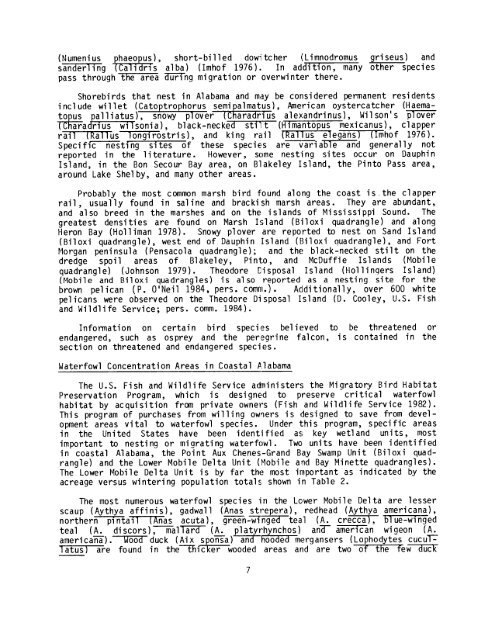ecological characterization atlas of coastal alabama - Data Center
ecological characterization atlas of coastal alabama - Data Center
ecological characterization atlas of coastal alabama - Data Center
Create successful ePaper yourself
Turn your PDF publications into a flip-book with our unique Google optimized e-Paper software.
(Numenius hap eopus), short-billed dowitcher ( Limnodromus griseus ) and<br />
sander Fing Cai rd Ts alba) ( Imh<strong>of</strong> 1976) . In addition, many other species<br />
pass through -t Fe -area U-uing migration or overwinter there .<br />
Shorebirds that nest in Alabama and may be considered permanent residents<br />
include willet ( Cato trophorus semipalmatus), American oystercatcher ( Haematopus<br />
palliatus), snowy p over ara rius alexandrinus), Wilson's pTover<br />
ara riudTs wi`Tsonia), black-neck e-d--s-t i'lt (Himantopus mexicanus), clapper<br />
rai a us-long ostris), and king rail (RaT uf s el Iegans mh<strong>of</strong> 1976) .<br />
Specifi~ting sites <strong>of</strong> these species are variaTTand generally not<br />
reported in the literature . However, some nesting sites occur on Dauphin<br />
I sl and, i n the Bon Secour Bay area, on Bl akel ey I sl and, the Pi nto Pass area,<br />
around Lake Shelby, and many other areas .<br />
Probably the most common marsh bird found along the coast is .the clapper<br />
rail, usually found in saline and brackish marsh areas . They are abundant,<br />
and also breed in the marshes and on the islands <strong>of</strong> Mississippi Sound . The<br />
greatest densities are found on Marsh Island ( Biloxi quadrangle) and along<br />
Heron Bay (Holliman 1978) . Snowy plover are reported to nest on Sand Island<br />
(Biloxi quadrangle), west end <strong>of</strong> Dauphin Island (Biloxi quadrangle), and Fort<br />
Morgan peninsula ( Pensacola quadrangle) ; and the black-necked stilt on the<br />
dredge spoil areas <strong>of</strong> Blakeley, Pinto, and McDuffie Islands (Mobile<br />
quadrangle) ( Johnson 1979) . Theodore Disposal Island ( Hollinqers Island)<br />
(Mobile and Biloxi quadrangles) is also reported as a nesting site for the<br />
brown pelican (P . O'Neil 1984, pers . comm .) . Additionally, over 600 white<br />
pelicans were observed on the Theodore Disposal Island (D . Cooley, U .S . Fish<br />
and Wildlife Service ; pers . comm . 1984) .<br />
Information on certain bird species believed to be threatened or<br />
endangered, such as osprey and the peregrine falcon, is contained in the<br />
section on threatened and endangered species .<br />
Waterfowl Concentration Areas in Coastal Alabama<br />
The U .S . Fish and Wildlife Service administers the Migratory Bird Habitat<br />
Preservation Program, which is designed to preserve critical waterfowl<br />
habi tat by ac qui si tion from pri vate owners ( Fi sh and Wi l dl i fe Serv ice 1982) .<br />
This program <strong>of</strong> purchases from willing owners is designed to save from development<br />
areas vital to waterfowl species . Under this program, specific areas<br />
in the United States have been identified as key wetland units, most<br />
important to nesting or migrating waterfowl . Two units have been identified<br />
in <strong>coastal</strong> Alabama, the Point Aux Chenes-Grand Bay Swamp Unit (Biloxi quadrangle)<br />
and the Lower Mobile Delta Unit (Mobile and Bay Minette quadrangles) .<br />
The Lower Mobi 1 e Del ta Uni t i s by far the most important as i ndicated by the<br />
acreage versus wintering population totals shown in Table 2 .<br />
The most numerous waterfowl speci es i n the Lower Mobi 1 e Del ta are lesser<br />
scaup ( Aythya affinis), gadwall ( Anas strepera), redhead ( Aythya americana),<br />
northern pintai nas acuta), green-wing~tea.1 (A . crecca , ue-winged<br />
teal (A . discors), malTa_r_cT_ ( A . platyrhynchos) an T american wigeon (A .<br />
ameri cana ) .-T~oo T duck ( Ai x sponsa )an7EF- ,oF do ed-mergansers ( Lophodytes cucuT--<br />
atus are found in the__Ric~ce -wooded areas and are two o t e ew cTucTc<br />
7
















